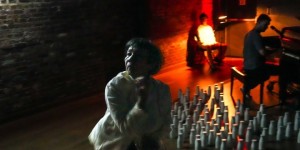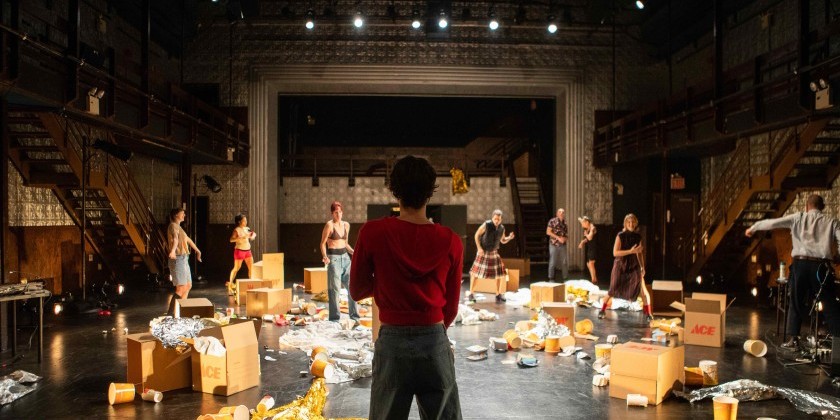Choreographer Carol Mendes Plays With Words (and more)

at LaMaMa's First floor Theater- September 10th -13th
Carol Mendes & Artists
“LANOTTE” and “VERSO”
September 10-13
Thursday, Friday, Saturday at 7:30 p.m. and Sunday at 3:30 p.m. for Tickets visit Brown Paper Tickets
Choreography: Carol Mendes & Artists
Artists: Frankie Fernandes, Lauren Elise Kravitz, and Erika Wuhrer
Costume Design: Lauren Beirne (“LANOTTE”) and Lauren Elise Kravitz (“VERSO”)
Lighting Design: Amith A. Chandrashaker
Music: Franz Liszt, Gramatik, Manu Chao, and Trentemøller
Apple.
Balloon.
Dog food.
Flower.
“Game of Thrones.”
This isn’t a weird shopping list. These are the names of actions devised by choreographer Carol Mendes and her three dancers (Frankie Fernandes, Lauren Elise Kravitz, and Erika Wuhrer) for “VERSO,” which along with “LANOTTE,” premieres at La MaMa the second weekend in September.
Born and raised in Brazil, Mendes moved to New York five years ago to pursue her MFA at New York University’s Tisch School of the Arts. Part of the impetus behind this relocation was to immerse herself in a supportive arts community. One overarching difference between the United States and Brazil is a lack of financial support for the arts at the individual level. Mendes says, “Brazilians are a cultured group by nature, but they don’t value the arts in a monetary way.” Furthermore, Brazilian society is plagued by rampant corruption, poverty, and violence. In the face of these more pressing problems, arts funding is swept aside. To cultivate a choreographic career, Mendes needed a new home.

After graduation in 2012, Mendes began work on “LANOTTE.” Stirred by Franz Liszt’s composition of the same name, she initially conceived of “LANOTTE” as a cerebral evening-length piece. She wanted to stitch the personal stories of her dancers into a tapestry that could reveal the universality of womanhood. As performers came and went and the choreography increased in quantity and detail, Mendes realized she had a problem: Dense and lushly textured, “LANOTTE” was too overwhelming to succeed as a full-length work. An antidote was needed.
Thus, “VERSO” was born. Mendes determined that she and her dancers needed to get out of their heads and into their bodies. It was the right call. “I built seven minutes of choreography in 30 minutes just by playing with physical challenges.” Quickly, she grasped that “LANOTTE” and “VERSO” were two sides of one coin; “VERSO” only made sense after “LANOTTE” and vice versa.
While they can operate as action and reaction, “LANOTTE” and “VERSO” are united by Mendes’ larger aim — to thwart expectations. “I’m always looking for things that don’t make sense.” Opposition, tension, unpredictability: these are the hallmarks of her artistic ethos. She elaborates, “If I get bored watching something in my work, I cut it.” Mendes believes her dances — if they are to compete in this hyperactive, multi-optioned world — must bewitch an audience. To accomplish this, she and her dancers tossed around random words (No dance vocabulary allowed!) and then invented corresponding movements. Acting as director and editor, Mendes harmonized these arbitrary words and their accompanying actions into cogent phrases.

At the heart of Mendes’ work is her tight relationship with her performers, who function as both muses and collaborators. She often works with women, but she disdains cute and girly in favor of gritty and ferocious, forging an aesthetic that’s more punk than princess. Mendes says, “The idea that women have to be pretty all the time bothers me.” She describes her dancers as “strong individuals” and shapes her work with their specific personalities in mind. “It’s because of them,” Mendes says, “that I have become more interesting.”
Share Your Audience Review. Your Words Are Valuable to Dance.
Are you going to see this show, or have you seen it? Share "your" review here on The Dance Enthusiast. Your words are valuable. They help artists, educate audiences, and support the dance field in general. There is no need to be a professional critic. Just click through to our Audience Review Section and you will have the option to write free-form, or answer our helpful Enthusiast Review Questionnaire, or if you feel creative, even write a haiku review. So join the conversation.















